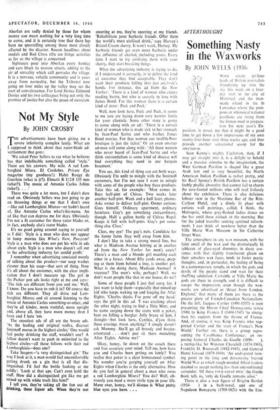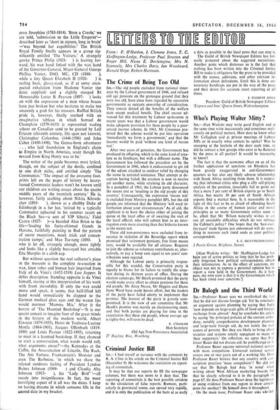Something Nasty in the Waxworks
AFTERTHOUGHT By JOHN WELLS (1936- ) SPECTATOR.
Sean Kenny's mighty Cyclotron, then, if I may get straight into it, is a delight to behold and a massive stimulus to the imagination, the West German Pavilion is shaped like a great Arab tent and is very beautiful, the North American Indian Pavilion is rather pretty, and Sir Basil Spence's British Pavilion has a certain feebly phallic absurdity that cannot fail to charm the sore-footed millions who will trail listlessly about the exhibition. There is also delicious lobster stew in the Maritime Bar of the Ritz- Carlton Hotel, and a dimly lit place with curious wall paintings, called, I think, the Metropole, where grey-fleshed ladies dance on the bar until three o'clock in the morning. But for the jaded traveller seeking spiritual refresh- ment, I can think of nowhere better than the Ville Marie Wax Museum in Ste Catherine Street West.
The atmosphere in any wax museum, with the faint smell of the wax and the dramatically lit tableaux of glass-eyed dummies in dusty cos- tumes with that slightly translucent gleam on their senseless wax faces, tends to foster poetic thoughts, and, in particular, the feeling of being in a contemporary temple, in which the gods and devils of the people stand and wait for their shuffling adulation. Certainly at Ville Marie the gods are there in strength, and it is difficult to escape the impression, even though the wax- works are advertised as 'direct from London. England,' that many of them arc there to the greater glory of French-Canadian Nationalism. On the left, Jacques Cartier (1491-1557) is seen presenting the Huron Chief Donnaconna (circa 1500) to King Francis I (1494-1547) `to streng- then his support from the throne of France. And, of course, it was King Francis who sup- ported Cartier and the start of France's New World.' Further on, there is a group repre- senting the Casablanca Conference: an im- posing General Charles de Gaulle (1890- ), a turnip-like Sir Winston Churchill (1874-1965), Franklin D. Roosevelt (1882-1945), and General Henri Giraud (1879-1949). 'An undisputed turn- ing point in the long and devastating Second World War at which tough-minded Allied leaders decided to accept nothing less than unconditional surrender. 'Of these FOUR GREAT MEN,' the Guide Book tells us, 'only de Gaulle remains alive.'
There is also a wax figure of Brigitte Bardot (1934- ) in a bath-towel, and one of Napoleon Bonaparte (1769-1821) with the Em- press Josephine (1763-1814). 'Born a Creole,' we are told, 'submission to the Little Emperor'— described later as 'short in stature, long in brain' =was beyond her capabilities' The British Royal Family finally appears in a group sig- nificantly entitled `The Visitors.' A strangely gawky Prince Philip (1921- ) is leaning for- ward, his wax hand linked with the wax hand of the Governor-General, Major-General George
Phillias Vanier, DSO, MC, CD (1888- ),
while a tiny Queen Elizabeth II (1926- ) is reeling back, glassy-eyed, as if at some unex- pected exhalation from Madame Vanier (no dates supplied) and a slightly stooped Rt Honourable Lester B. Pearson (1897- ) looks on with the expression of a man whose braces have just broken but who hesitates to make too unseemly a grab for his trousers. Ruffled British pride is, however, finally soothed with an imaginative tableau in which Samuel de Champlain (1570-1635) is represented wading ashore on Canadian sand to be greeted by Leif Ericson (eleventh century, life span not known), Christopher Columbus (1446-1506) and John Cabot (1450-1498), 'the Genoa-born adventurer . . . who laid foundation to England's claim to Empire in North America, scant though his reward from King Henry was to be.'
The writer of the guide becomes most lyrical, though, on the subject of the devils, confined in one drab niche, and entitled simply The Communists.' `The impact of the awesome foot- prints left on the pages of history by heavy- footed Communist leaders won't be known until our children are writing essays about the quaint middle years of the twentieth century.' He is, however, fairly scathing about Nikita Khrush- chev (1895- ), shown as a chubby Duke of Edinburgh in a fur hat, 'retired by a typically Communist upheaval to his summer resort on the Black Sea—a sort of VIP Siberia,' Fidel Castro (1927- )—a bearded Alan Brien to the life—leading his fuzzy-chinned friends in Havana, faithfully painting in Red the pattern of secret executions, mock trials and concen- tration camps,' and Mao Tse-tung (1893- ), who is let off, strangely enough, more lightly and looks like a slightly boss-eyed but amiable Ena Sharpies in a cloth cap.
But without question the real collector's piece in the museum is the complete re-creation in wax, linen robes and human hair imported from Italy of da Vinci's (1452-1519) Last Supper. It defies description. Standing opposite is da Vinci himself, staring at this interpretation of his work with frank incredulity. If only the wax could move and speak, it seems, that half-lifted left hand would immediately be clapped to the German medical glass eyes and the waxen lips would murmur `Mamma Mia.' After it the horror of `The Haunted Bookshop'—`It is our quaint conceit to imagine four of the great minds in the history of the modern world, Albert Einstein (1879-1955), Henri de Toulouse-Lautrec Monfa (1864-1901), Jacques Offenbach (1819- 1880) and Louis Pasteur (1822-1895), returning to meet in a haunted bookshop. If they chanced to start a conversation, what words would roll, what arguments ensue?'—the Kennedys at the Coffin, the Assassination of Lincoln, The Rack, The Ant Torture, Frankenstein's Monster and even The Barbecue, 'in which we share the relaxed outdoors feeling of President Lyndon
Baines Johnson (1908- ) and Claudia Alta Johnson (1913- ), his "Lady Bird" '—all
recede into insignificance. In fact, the most horrifying aspect of it all was the dates. I keep on having dreams in which someone fills in the second date in my bracket.































 Previous page
Previous page